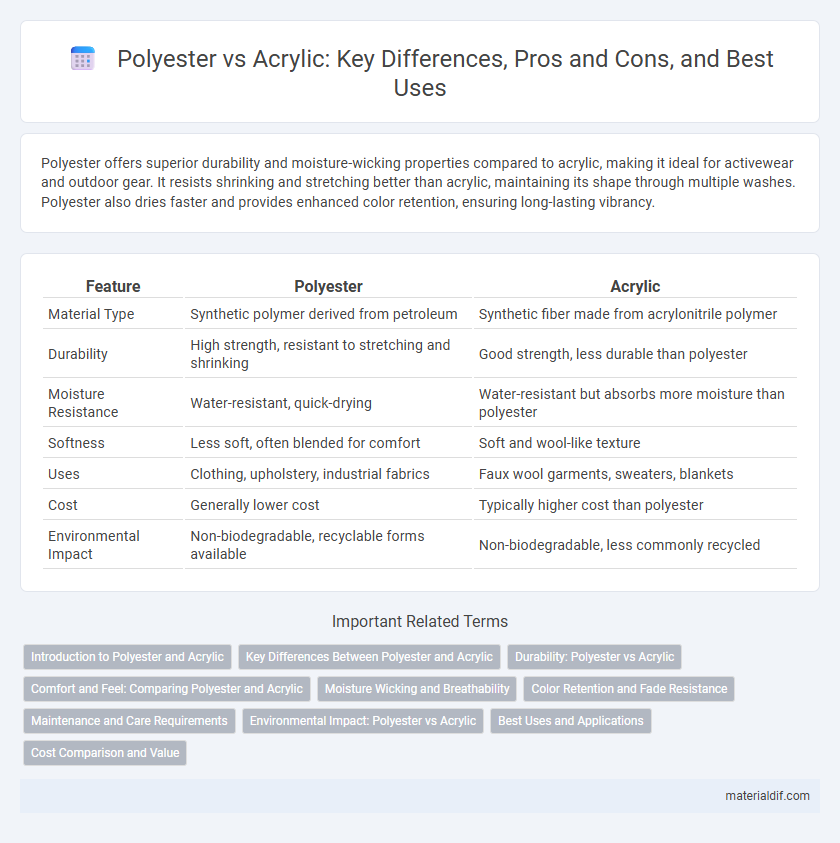Polyester offers superior durability and moisture-wicking properties compared to acrylic, making it ideal for activewear and outdoor gear. It resists shrinking and stretching better than acrylic, maintaining its shape through multiple washes. Polyester also dries faster and provides enhanced color retention, ensuring long-lasting vibrancy.
Table of Comparison
| Feature | Polyester | Acrylic |
|---|---|---|
| Material Type | Synthetic polymer derived from petroleum | Synthetic fiber made from acrylonitrile polymer |
| Durability | High strength, resistant to stretching and shrinking | Good strength, less durable than polyester |
| Moisture Resistance | Water-resistant, quick-drying | Water-resistant but absorbs more moisture than polyester |
| Softness | Less soft, often blended for comfort | Soft and wool-like texture |
| Uses | Clothing, upholstery, industrial fabrics | Faux wool garments, sweaters, blankets |
| Cost | Generally lower cost | Typically higher cost than polyester |
| Environmental Impact | Non-biodegradable, recyclable forms available | Non-biodegradable, less commonly recycled |
Introduction to Polyester and Acrylic
Polyester is a synthetic fiber known for its durability, wrinkle resistance, and moisture-wicking properties, commonly used in apparel and home textiles. Acrylic, another synthetic fiber, mimics wool with a soft texture and excellent insulation, often found in sweaters, blankets, and outdoor fabrics. Both fibers offer unique benefits, with polyester excelling in strength and quick drying, while acrylic provides warmth and a lightweight feel.
Key Differences Between Polyester and Acrylic
Polyester and acrylic differ primarily in their fiber composition, with polyester made from polyesters derived from petroleum and acrylic made from polyacrylonitrile polymer. Polyester offers superior durability, moisture-wicking, and resistance to shrinking and stretching, making it ideal for activewear and outdoor gear, whereas acrylic fibers excel in softness and mimic wool's insulating properties, commonly used in sweaters and knitwear. Both fibers are synthetic but diverge significantly in texture, moisture management, and thermal insulation, influencing their applications in textiles and fashion industries.
Durability: Polyester vs Acrylic
Polyester exhibits superior durability compared to acrylic due to its higher resistance to abrasion, stretching, and shrinking. The synthetic structure of polyester enables it to withstand prolonged exposure to sunlight and moisture without significant degradation, making it ideal for outdoor applications. In contrast, acrylic fibers tend to be less resilient under intense physical stress and environmental factors, which can lead to faster wear and tear.
Comfort and Feel: Comparing Polyester and Acrylic
Polyester offers a smoother, silkier texture and tends to be more breathable, making it ideal for activewear and everyday comfort. Acrylic fibers often feel bulkier and warmer, mimicking wool but lacking the lightweight softness of polyester. When prioritizing comfort and feel, polyester excels due to its moisture-wicking properties and softer hand, whereas acrylic is better suited for insulation and warmth.
Moisture Wicking and Breathability
Polyester excels in moisture-wicking capabilities by efficiently drawing sweat away from the skin, promoting faster evaporation and keeping the wearer dry during physical activities. In contrast, acrylic tends to retain moisture, resulting in less effective breathability and increased discomfort in warm or humid conditions. The superior breathability of polyester fibers enhances ventilation, making it a preferred choice for activewear and performance garments over acrylic.
Color Retention and Fade Resistance
Polyester exhibits superior color retention and fade resistance compared to acrylic, maintaining vibrant hues even after prolonged exposure to sunlight and repeated washing. The inherent hydrophobic properties of polyester fibers minimize dye loss and prevent fading, making it ideal for outdoor and high-use applications. Acrylic tends to fade more quickly due to its porous fiber structure, which allows dyes to wash out faster under harsh conditions.
Maintenance and Care Requirements
Polyester requires minimal maintenance, offering excellent resistance to wrinkles, shrinking, and stretching, and it can be machine washed and dried without special care. Acrylic fibers, while also machine washable, tend to pill over time and require gentler handling, such as washing in cold water and air drying to maintain fabric quality. Polyester's durability and ease of care make it a more practical choice for everyday use compared to acrylic's moderate maintenance needs.
Environmental Impact: Polyester vs Acrylic
Polyester and acrylic differ significantly in their environmental impact, with polyester primarily derived from petroleum-based polymers and acrylic produced from acrylonitrile, a toxic chemical. Polyester's widespread use leads to substantial microplastic pollution during washing, while acrylic also contributes to microplastic release but tends to degrade slower in marine environments. Both fibers pose challenges in recyclability and carbon footprint, but advancements in recycled polyester offer a slightly more sustainable alternative compared to conventional acrylic production.
Best Uses and Applications
Polyester excels in moisture-wicking and durability, making it ideal for activewear, outdoor gear, and upholstery that require resistance to stretching and shrinking. Acrylic, known for its wool-like softness and insulating properties, is best suited for sweaters, blankets, and lightweight winter garments where warmth and comfort are priorities. Choosing polyester or acrylic depends on the specific application demands, with polyester preferred for strength and moisture management, while acrylic is favored for softness and thermal insulation.
Cost Comparison and Value
Polyester is generally more cost-effective than acrylic, offering a lower price per yard while maintaining durability and colorfastness. Acrylic fibers tend to be pricier due to their wool-like texture and greater warmth retention, but polyester provides better moisture resistance and quicker drying times, enhancing overall value. When considering long-term use and maintenance, polyester often delivers superior cost-efficiency for budget-conscious consumers without compromising performance.
Polyester vs Acrylic Infographic

 materialdif.com
materialdif.com